Evaluating Lumbar Biomechanics for Work-Related Musculoskeletal Disorders at Varying Working Heights During Wall Construction Tasks
Abstract
1. Introduction
2. Materials and Methods
2.1. Participants
2.2. Experimental Setup and Process
2.3. Motion Data Collection
2.4. Three-Dimensional Musculoskeletal Modeling Simulation
2.5. Measurement by Surface Electromyography (sEMG)
2.6. Statistical Analysis
3. Results
3.1. Analysis of Simulated Results from the MSK Model
3.1.1. Effect of Working Heights on Muscle Activity During Mortar-Spreading Task (Task-A)
3.1.2. Effect of Working Heights on Muscle Activity During Bricklaying Task (Task-B)
3.2. Analysis of Experimental Results from the sEMG Sensors
4. Discussion
4.1. Effect of Working Heights on Lower-Back Muscles During Mortar-Spreading Task (Task-A)
4.2. Effect of Working Heights on Lower-Back Muscles During Bricklaying Task (Task-B)
4.3. Implications and Limitations
5. Conclusions
Author Contributions
Funding
Institutional Review Board Statement
Informed Consent Statement
Data Availability Statement
Acknowledgments
Conflicts of Interest
References
- Yap, J.B.H.; Lam, C.G.Y.; Skitmore, M.; Talebian, N. Barriers to the Adoption of New Safety Technologies in Construction: A Developing Country Context. J. Civ. Eng. Manag. 2022, 28, 120–133. [Google Scholar] [CrossRef]
- Boadu, E.F.; Wang, C.C.; Sunindijo, R.Y. Characteristics of the Construction Industry in Developing Countries and Its Implications for Health and Safety: An Exploratory Study in Ghana. Int. J. Environ. Res. Public Health 2020, 17, 4110. [Google Scholar] [CrossRef] [PubMed]
- Antwi-Afari, M.F.; Li, H.; Anwer, S.; Li, D.; Yu, Y.; Mi, H.-Y.; Wuni, I.Y. Assessment of a Passive Exoskeleton System on Spinal Biomechanics and Subjective Responses during Manual Repetitive Handling Tasks among Construction Workers. Saf. Sci. 2021, 142, 105382. [Google Scholar] [CrossRef]
- Valero, E.; Sivanathan, A.; Bosche, F.; Abdel-Wahab, M. Musculoskeletal Disorders in Construction: A Review and a Novel System for Activity Tracking with Body Area Network. Appl. Ergon. 2016, 54, 120–130. [Google Scholar] [CrossRef] [PubMed]
- Mamin, F.A.; Dey, G.; Das, S.K. Health and Safety Issues among Construction Workers in Bangladesh. Int. J. Occup. Saf. Health 2019, 9, 13–18. [Google Scholar] [CrossRef]
- Rahman, M.S.; Sakamoto, J. The Risk Factors for the Prevalence of Work-Related Musculoskeletal Disorders among Construction Workers: A Review. J. Appl. Res. Ind. Eng. 2024, 11, 155–165. [Google Scholar] [CrossRef]
- Jeong, S.; Lee, B.-H. The Moderating Effect of Work-Related Musculoskeletal Disorders in Relation to Occupational Stress and Health-Related Quality of Life of Construction Workers: A Cross-Sectional Research. BMC Musculoskelet. Disord. 2024, 25, 147. [Google Scholar] [CrossRef]
- Chen, J.; Qiu, J.; Ahn, C. Construction Worker’s Awkward Posture Recognition through Supervised Motion Tensor Decomposition. Autom. Constr. 2017, 77, 67–81. [Google Scholar] [CrossRef]
- Jaffar, N.; Abdul-Tharim, A.H.; Mohd-Kamar, I.F.; Lop, N.S. A Literature Review of Ergonomics Risk Factors in Construction Industry. Procedia Eng. 2011, 20, 89–97. [Google Scholar] [CrossRef]
- Sterud, T.; Johannessen, H.A.; Tynes, T. Work-Related Psychosocial and Mechanical Risk Factors for Neck/Shoulder Pain: A 3-Year Follow-up Study of the General Working Population in Norway. Int. Arch. Occup. Environ. Health 2014, 87, 471–481. [Google Scholar] [CrossRef] [PubMed]
- Andersen, L.L.; Fallentin, N.; Thorsen, S.V.; Holtermann, A. Physical Workload and Risk of Long-Term Sickness Absence in the General Working Population and among Blue-Collar Workers: Prospective Cohort Study with Register Follow-Up. Occup. Environ. Med. 2016, 73, 246–253. [Google Scholar] [CrossRef] [PubMed]
- Wilkie, R.; Pransky, G. Improving Work Participation for Adults with Musculoskeletal Conditions. Best Pract. Res. Clin. Rheumatol. 2012, 26, 733–742. [Google Scholar] [CrossRef] [PubMed]
- Soares, C.O.; Pereira, B.F.; Pereira Gomes, M.V.; Marcondes, L.P.; de Campos Gomes, F.; de Melo-Neto, J.S. Preventive Factors against Work-Related Musculoskeletal Disorders: Narrative Review. Rev. Bras. Med. Trab. Publicacao Assoc. Nac. Med. Trab.—ANAMT 2019, 17, 415–430. [Google Scholar] [CrossRef]
- Albers, J.T.; Hudock, S.D. Biomechanical Assessment of Three Rebar Tying Techniques. Int. J. Occup. Saf. Ergon. 2007, 13, 279–289. [Google Scholar] [CrossRef] [PubMed]
- Grzywinski, W.; Wandycz, A.; Tomczak, A.; Jelonek, T. The Prevalence of Self-Reported Musculoskeletal Symptoms among Loggers in Poland. Int. J. Ind. Ergon. 2016, 52, 12–17. [Google Scholar] [CrossRef]
- Wang, D.; Dai, F.; Ning, X. Risk Assessment of Work-Related Musculoskeletal Disorders in Construction: State-of-the-Art Review. J. Constr. Eng. Manag. 2015, 141, 04015008. [Google Scholar] [CrossRef]
- Hess, J.; Weinstein, M.; Welch, L. Ergonomic Best Practices in Masonry: Regional Differences, Benefits, Barriers, and Recommendations for Dissemination. J. Occup. Environ. Hyg. 2010, 7, 446–455. [Google Scholar] [CrossRef] [PubMed]
- Lewis, C.; Wahlstrom, J.; Mukka, S.; Liv, P.; Jarvholm, B.; Jackson, J.A. Surgery for Subacromial Impingement Syndrome and Occupational Biomechanical Risk Factors in a 16-Year Prospective Study among Male Construction Workers. Scand. J. Work. Environ. Health 2023, 49, 156–163. [Google Scholar] [CrossRef] [PubMed]
- Rybski, M.F.; Juckett, L. Posture. In Kinesiology for Occupational Therapy; Routledge: New York, NY, USA, 2019; ISBN 978-1-003-52472-4. [Google Scholar]
- Debora, S.; Suryadi, A. Analysis of Cleaning Service Work Postures to Reduce Musculoskeletal Injuries with the Posture Evaluation Index Approach. J. Multiapp 2025, 6, 12–22. [Google Scholar] [CrossRef]
- Sumon, R.M.; Yazaki, T.; Chihara, T.; Sakamoto, J. Correlation between Lower Back Muscle Activity and Trunk Flexion during Wall Construction Tasks. J. Biomech. Sci. Eng. 2025, 20, 24-00392. [Google Scholar] [CrossRef]
- Skals, S.; De Zee, M.; Skipper Andersen, M. Estimation of Joint Kinetics During Manual Material Handling Using Inertial Motion Capture: A Follow-Up Study. J. Biomech. Eng. 2025, 147, 021003. [Google Scholar] [CrossRef] [PubMed]
- Hahnemann, Y.; Weiss, M.; Bernek, M.; Boblan, I.; Gotz, S. Advancing Biomechanical Simulations: A Novel Pseudo-Rigid-Body Model for Flexible Beam Analysis. Biomechanics 2024, 4, 566–584. [Google Scholar] [CrossRef]
- Zadon, H.; Michnik, R.; Nowakowska-Lipiec, K. Assessment of Musculoskeletal Loads among Office Workers Due to Predicted BMI Increase. Appl. Sci. 2024, 14, 8928. [Google Scholar] [CrossRef]
- Takeshita, Y.; Kawada, M.; Miyazaki, T.; Nakai, Y.; Araki, S.; Nakatsuji, S.; Matsuzawa, Y.; Nakashima, S.; Kiyama, R. Effects of Knee Flexion Angles on the Joint Force and Muscle Force during Bridging Exercise: A Musculoskeletal Model Simulation. J. Healthc. Eng. 2022, 2022, 7975827. [Google Scholar] [CrossRef] [PubMed]
- Bangaru, S.S.; Wang, C.; Aghazadeh, F. Automated and Continuous Fatigue Monitoring in Construction Workers Using Forearm EMG and IMU Wearable Sensors and Recurrent Neural Network. Sensors 2022, 22, 9729. [Google Scholar] [CrossRef] [PubMed]
- Kang, S.H.; Mirka, G.A. Load Transfer between Active and Passive Lumbar Tissues and Its Implications in Time-Dependent EMG-Assisted Biomechanical Modeling. J. Biomech. 2025, 183, 112600. [Google Scholar] [CrossRef] [PubMed]
- Antwi-Afari, M.F.; Li, H.; Edwards, D.J.; Pärn, E.A.; Seo, J.; Wong, A.Y.L. Biomechanical Analysis of Risk Factors for Work-Related Musculoskeletal Disorders during Repetitive Lifting Task in Construction Workers. Autom. Constr. 2017, 83, 41–47. [Google Scholar] [CrossRef]
- Kong, Y.-K.; Choi, K.-H.; Cho, M.-U.; Kim, S.-Y.; Kim, M.-J.; Shim, J.-W.; Park, S.-S.; Kim, K.-R.; Seo, M.-T.; Chae, H.-S.; et al. Ergonomic Assessment of a Lower-Limb Exoskeleton through Electromyography and Anybody Modeling System. Int. J. Environ. Res. Public Health 2022, 19, 8088. [Google Scholar] [CrossRef] [PubMed]
- Harrington, M.S.; Burkhart, T.A. Validation of a Musculoskeletal Model to Investigate Hip Joint Mechanics in Response to Dynamic Multiplanar Tasks. J. Biomech. 2023, 158, 111767. [Google Scholar] [CrossRef] [PubMed]
- Ye, B.; Liu, G.; He, Z.; Xu, J.; Pan, H.; Zhu, H. Biomechanical Mechanisms of Anterior Cruciate Ligament Injury in the Jerk Dip Phase of Clean and Jerk: A Case Study of an Injury Event Captured on-Site. Heliyon 2024, 10, e31390. [Google Scholar] [CrossRef]
- Zhang, W.; Yang, H.; Li, Y.; Zhao, Y.; Xu, H. An Optimization Model of Tractor Clutch Pedal Design Parameters Based on Lower Limb Biomechanical Characteristics. Int. J. Ind. Ergon. 2023, 98, 103519. [Google Scholar] [CrossRef]
- Theodorakos, I.; Andersen, M.S. Influence of the Initial Guess on the Estimation of Knee Ligament Parameters via Optimization Procedures. Bioengineering 2024, 11, 1183. [Google Scholar] [CrossRef] [PubMed]
- Acar, M.; Erdil, Y.Z.; Ozcan, C. Computer-Aided Ergonomic Analysis of Primary School Furniture Dimensions. Ergonomics 2025, 68, 1–18. [Google Scholar] [CrossRef] [PubMed]
- Rahman, S.; Yazaki, T.; Chihara, T.; Sakamoto, J. Effect of Working Heights on Body Postures During Wall Construction Tasks: Investigation of Bending and Twisting Movements. In Proceedings of the 15th International Conference on Industrial Engineering and Operations Management, Singapore, 18–20 February 2025. [Google Scholar]
- Perception Neuron 3 Hardware List. Available online: https://support.neuronmocap.com/hc/en-us/articles/4401815074203-Perception-Neuron-3-Hardware-List (accessed on 28 March 2025).
- Choo, C.Z.Y.; Chow, J.Y.; Komar, J. Validation of the Perception Neuron System for Full-Body Motion Capture. PLoS ONE 2022, 17, e0262730. [Google Scholar] [CrossRef] [PubMed]
- Wu, Y.; Tao, K.; Chen, Q.; Tian, Y.; Sun, L. A Comprehensive Analysis of the Validity and Reliability of the Perception Neuron Studio for Upper-Body Motion Capture. Sensors 2022, 22, 6954. [Google Scholar] [CrossRef] [PubMed]
- Damsgaard, M.; Rasmussen, J.; Christensen, S.T.; Surma, E.; De Zee, M. Analysis of Musculoskeletal Systems in the AnyBody Modeling System. Simul. Model. Pract. Theory 2006, 14, 1100–1111. [Google Scholar] [CrossRef]
- Bassani, T.; Stucovitz, E.; Qian, Z.; Briguglio, M.; Galbusera, F. Validation of the AnyBody Full Body Musculoskeletal Model in Computing Lumbar Spine Loads at L4L5 Level. J. Biomech. 2017, 58, 89–96. [Google Scholar] [CrossRef] [PubMed]
- Daroudi, S.; Arjmand, N.; Mohseni, M.; El-Rich, M.; Parnianpour, M. Evaluation of Ground Reaction Forces and Centers of Pressure Predicted by AnyBody Modeling System during Load Reaching/Handling Activities and Effects of the Prediction Errors on Model-Estimated Spinal Loads. J. Biomech. 2024, 164, 111974. [Google Scholar] [CrossRef] [PubMed]
- Singhvi, P.M.; Bharnuke, J.K. A Cross-Sectional Study on Association of Iliopsoas Muscle Length with Lumbar Lordosis Among Desk Job Workers. Indian J. Occup. Environ. Med. 2024, 28, 235–238. [Google Scholar] [CrossRef] [PubMed]
- Liu, Y.; Yuan, L.; Zeng, Y.; Ni, J.; Yan, S. The Difference in Paraspinal Muscle Parameters and the Correlation with Health-Related Quality of Life among Healthy Individuals, Patients with Degenerative Lumbar Scoliosis and Lumbar Spinal Stenosis. J. Pers. Med. 2023, 13, 1438. [Google Scholar] [CrossRef] [PubMed]
- Hermens, H.J.; Freriks, B.; Disselhorst-Klug, C.; Rau, G. Development of Recommendations for SEMG Sensors and Sensor Placement Procedures. J. Electromyogr. Kinesiol. 2000, 10, 361–374. [Google Scholar] [CrossRef] [PubMed]
- Hambly, M.J.; de Sousa, A.C.C.; Pizzolato, C. Comparison of Filtering Methods for Real-Time Extraction of the Volitional EMG Component in Electrically Stimulated Muscles. Biomed. Signal Process. Control 2024, 87, 105471. [Google Scholar] [CrossRef]
- Yousif, H.A.; Zakaria, A.; Rahim, N.A.; Salleh, A.F.B.; Mahmood, M.; Alfarhan, K.A.; Kamarudin, L.M.; Mamduh, S.M.; Hasan, A.M.; Hussain, M.K. Assessment of Muscles Fatigue Based on Surface EMG Signals Using Machine Learning and Statistical Approaches: A Review. IOP Conf. Ser. Mater. Sci. Eng. 2019, 705, 012010. [Google Scholar] [CrossRef]
- Cohen, J. Statistical Power Analysis for the Behavioral Sciences; Routledge: New York, NY, USA, 2013; ISBN 978-1-134-74270-7. [Google Scholar]
- Afolabi, A.; Yusuf, A.; Akanmu, A. Effect of a Passive Shoulder-Support Exoskeleton on Muscle Activity, Range of Motion, Discomfort, and Exertion during Painting Tasks. J. Constr. Eng. Manag. 2025, 151, 04025027. [Google Scholar] [CrossRef]
- Trafimow, J.H.; Schipplein, O.D.; Novak, G.J.; Andersson, G.B.J. The Effects of Quadriceps Fatigue on the Technique of Lifting. Spine 1993, 18, 364–367. [Google Scholar] [CrossRef] [PubMed]
- Skals, S.; Blafoss, R.; De Zee, M.; Andersen, L.L.; Andersen, M.S. Effects of Load Mass and Position on the Dynamic Loading of the Knees, Shoulders and Lumbar Spine during Lifting: A Musculoskeletal Modelling Approach. Appl. Ergon. 2021, 96, 103491. [Google Scholar] [CrossRef] [PubMed]
- Ojha, A.; Guo, H.; Jebelli, H.; Martin, A.; Akanmu, A. Assessing the Impact of Active Back Support Exoskeletons on Muscular Activity during Construction Tasks: Insights from Physiological Sensing. In Proceedings of the Computing in Civil Engineering 2023, Corvallis, OR, USA, 25–28 June 2023; pp. 340–347. [Google Scholar]
- Jensen, B.R.; Pilegaard, M.; Sjogaard, G. Motor Unit Recruitment and Rate Coding in Response to Fatiguing Shoulder Abductions and Subsequent Recovery. Eur. J. Appl. Physiol. 2000, 83, 190–199. [Google Scholar] [CrossRef] [PubMed]
- Wærsted, M.; Koch, M.; Veiersted, K.B. Work above Shoulder Level and Shoulder Complaints: A Systematic Review. Int. Arch. Occup. Environ. Health 2020, 93, 925–954. [Google Scholar] [CrossRef] [PubMed]
- Brandt, M.; Blafoss, R.; Jakobsen, M.D.; Samani, A.; Ajslev, J.Z.N.; Madeleine, P.; Andersen, L.L. Influence of Brick Laying Height on Biomechanical Load in Masons: Cross-Sectional Field Study with Technical Measurements. Work 2024, 79, 459–470. [Google Scholar] [CrossRef] [PubMed]
- Hayashi, S.; Katsuhira, J.; Matsudaira, K.; Maruyama, H. Effect of Pelvic Forward Tilt on Low Back Compressive and Shear Forces during a Manual Lifting Task. J. Phys. Ther. Sci. 2016, 28, 802–806. [Google Scholar] [CrossRef] [PubMed][Green Version]
- Fallentin, N.; Jorgensen, K.; Simonsen, E.B. Motor Unit Recruitment during Prolonged Isometric Contractions. Eur. J. Appl. Physiol. 1993, 67, 335–341. [Google Scholar] [CrossRef] [PubMed]
- Kozlenia, D.; Kochan-Jachec, K. The Impact of Interaction between Body Posture and Movement Pattern Quality on Injuries in Amateur Athletes. J. Clin. Med. 2024, 13, 1456. [Google Scholar] [CrossRef] [PubMed]
- Lee, H.; Hong, J.H. Comparison of Trunk Muscle Activities in Lifting and Lowering Tasks at Various Heights. J. Phys. Ther. Sci. 2016, 28, 585–588. [Google Scholar] [CrossRef] [PubMed][Green Version]
- Barthelme, J.; Sauter, M.; Mueller, C.; Liebers, F. Association between Working in Awkward Postures, in Particular Overhead Work, and Pain in the Shoulder Region in the Context of the 2018 BIBB/BAuA Employment Survey. BMC Musculoskelet. Disord. 2021, 22, 624. [Google Scholar] [CrossRef] [PubMed]
- Shin, S.; Yoo, W. Effects of Below-Knee Assembly Work at Different Reach Distances on Upper-Extremity Muscle Activity. J. Phys. Ther. Sci. 2014, 26, 1277–1278. [Google Scholar] [CrossRef] [PubMed][Green Version]
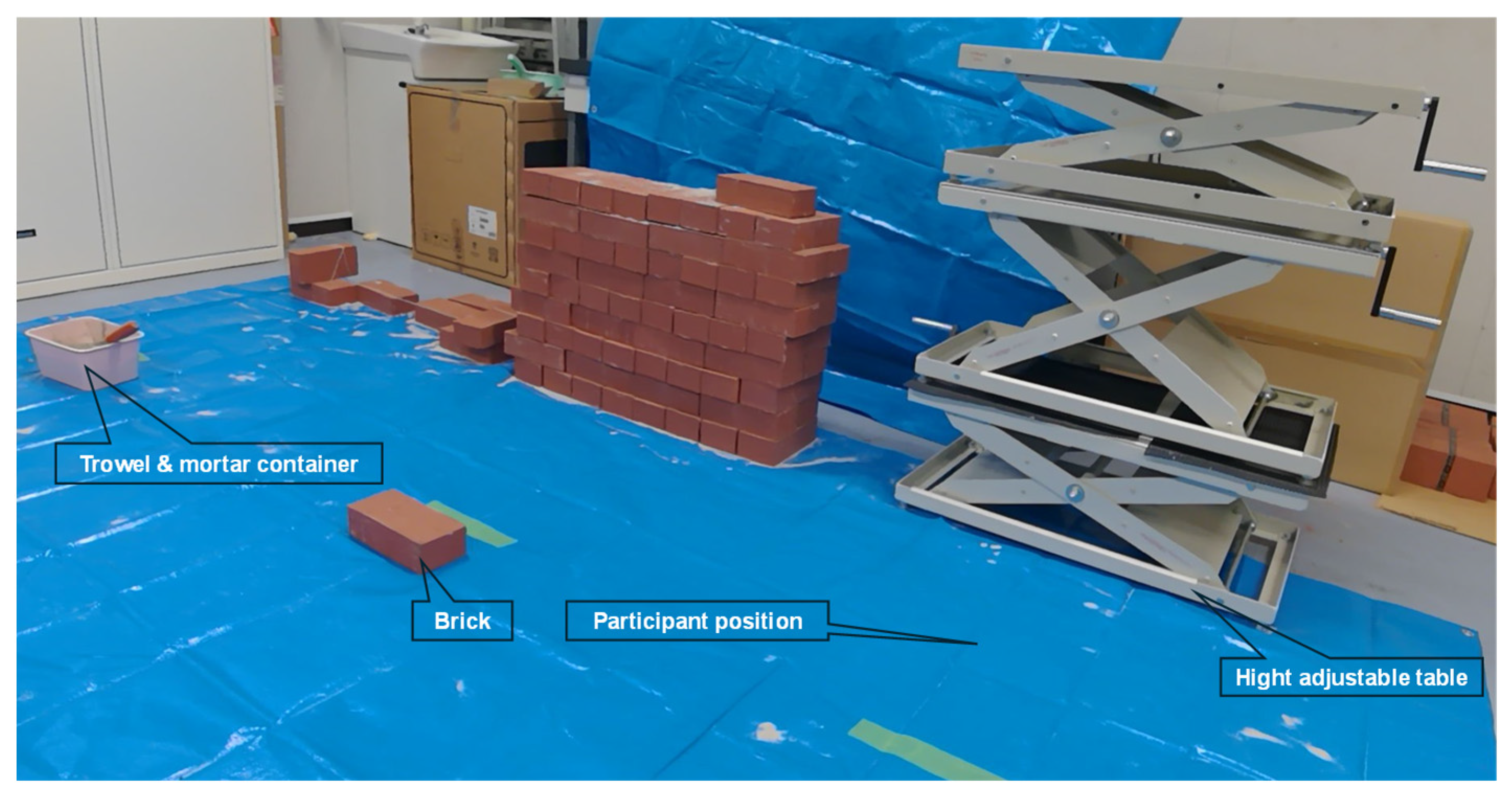
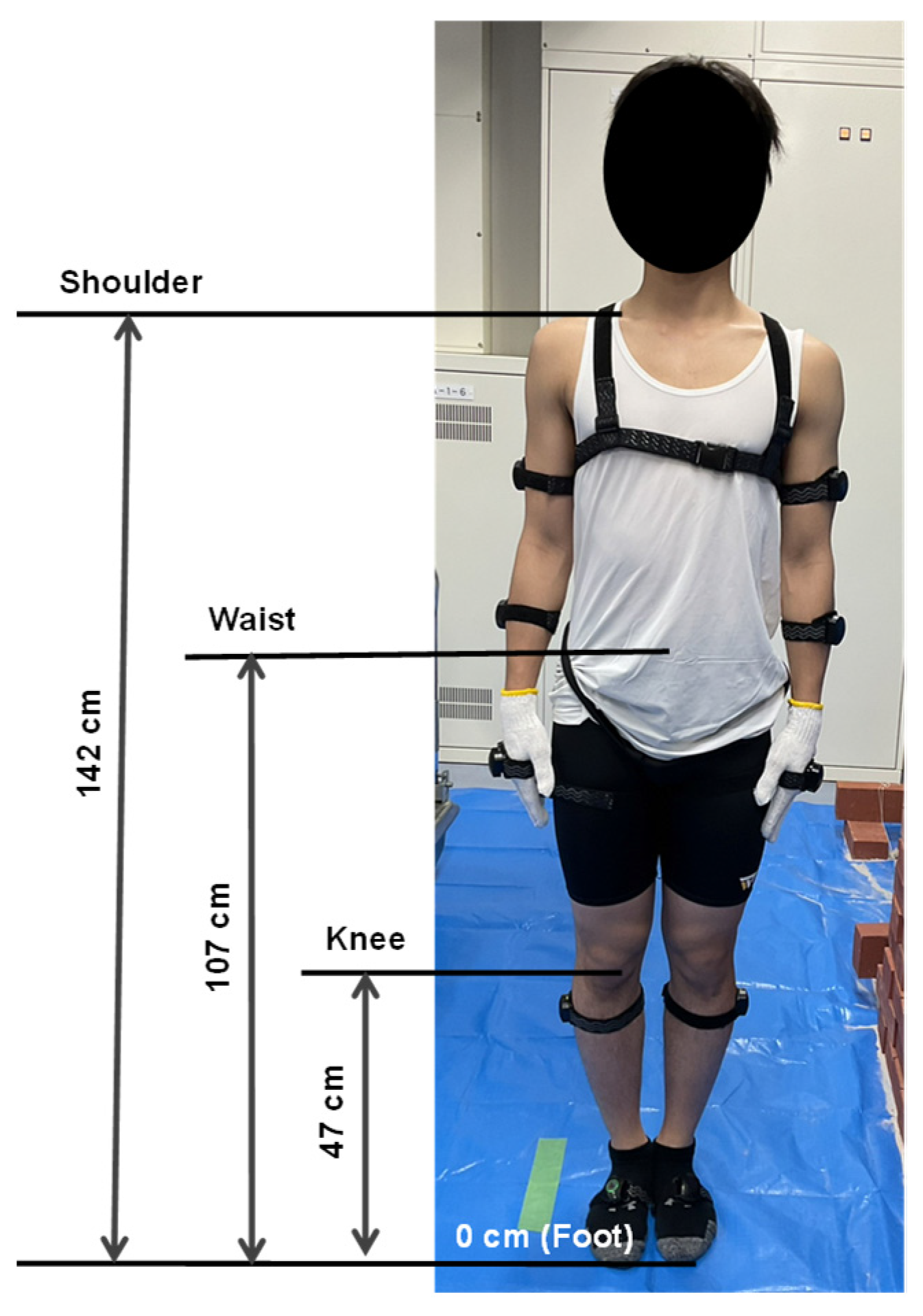
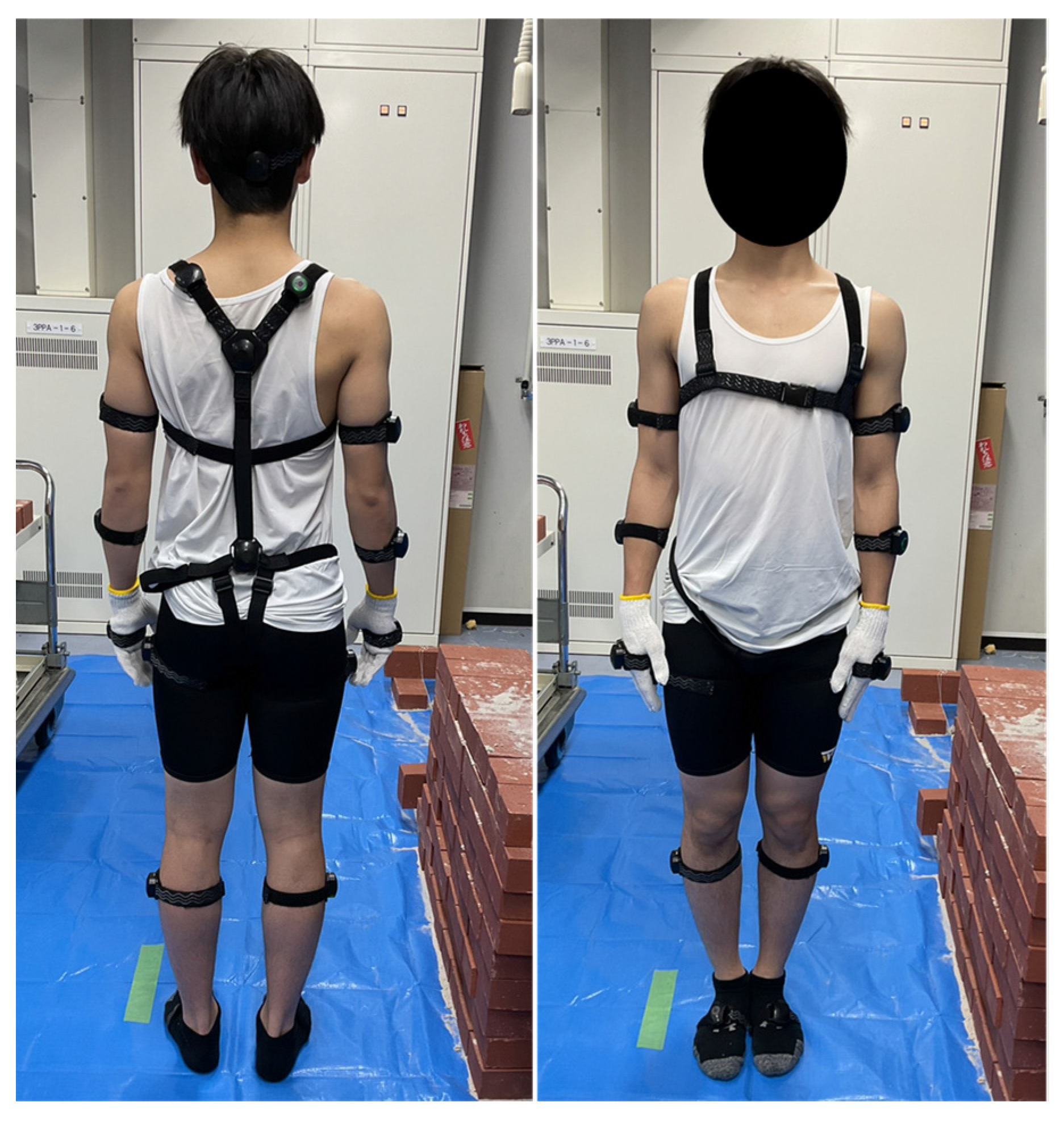


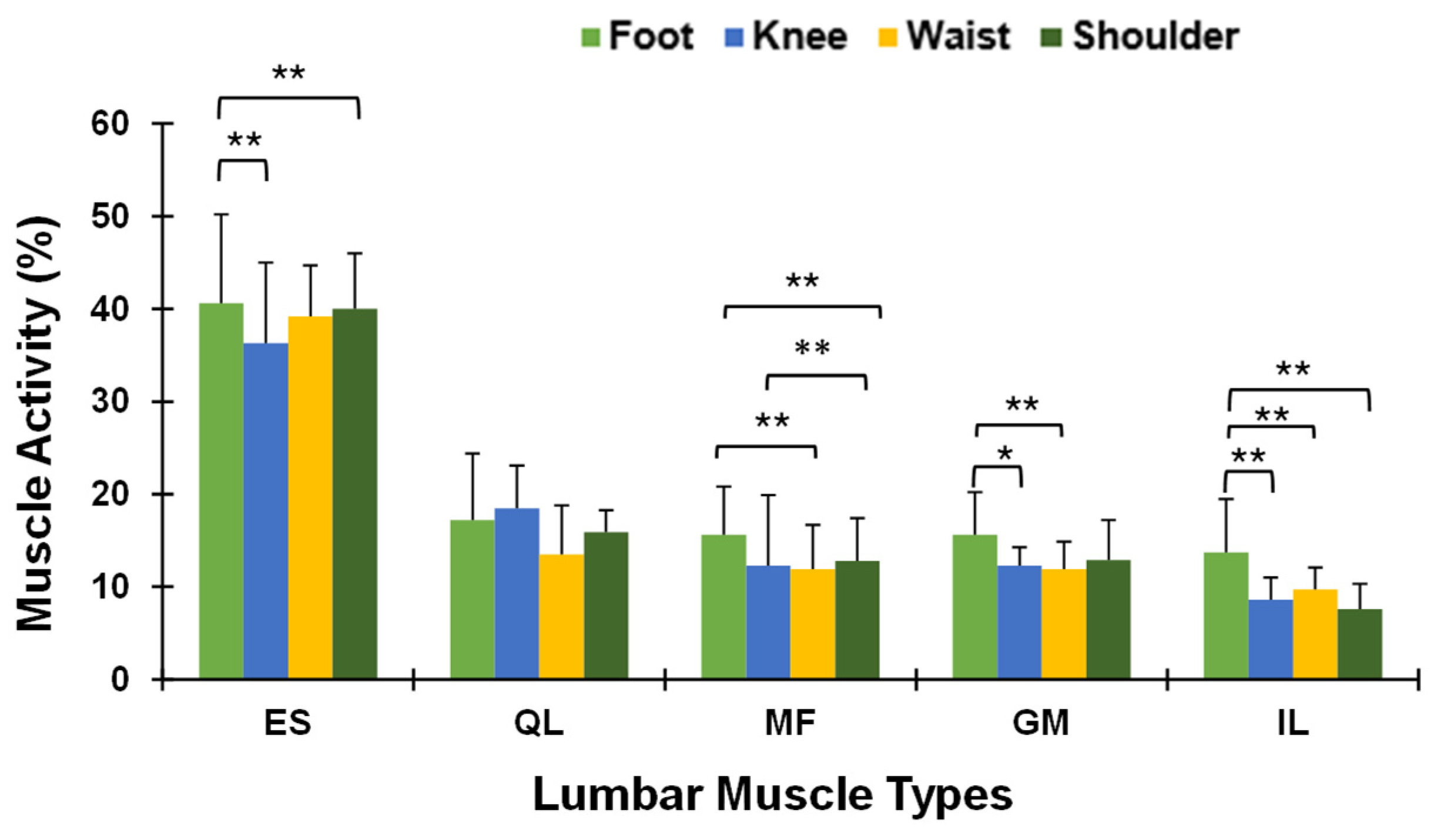
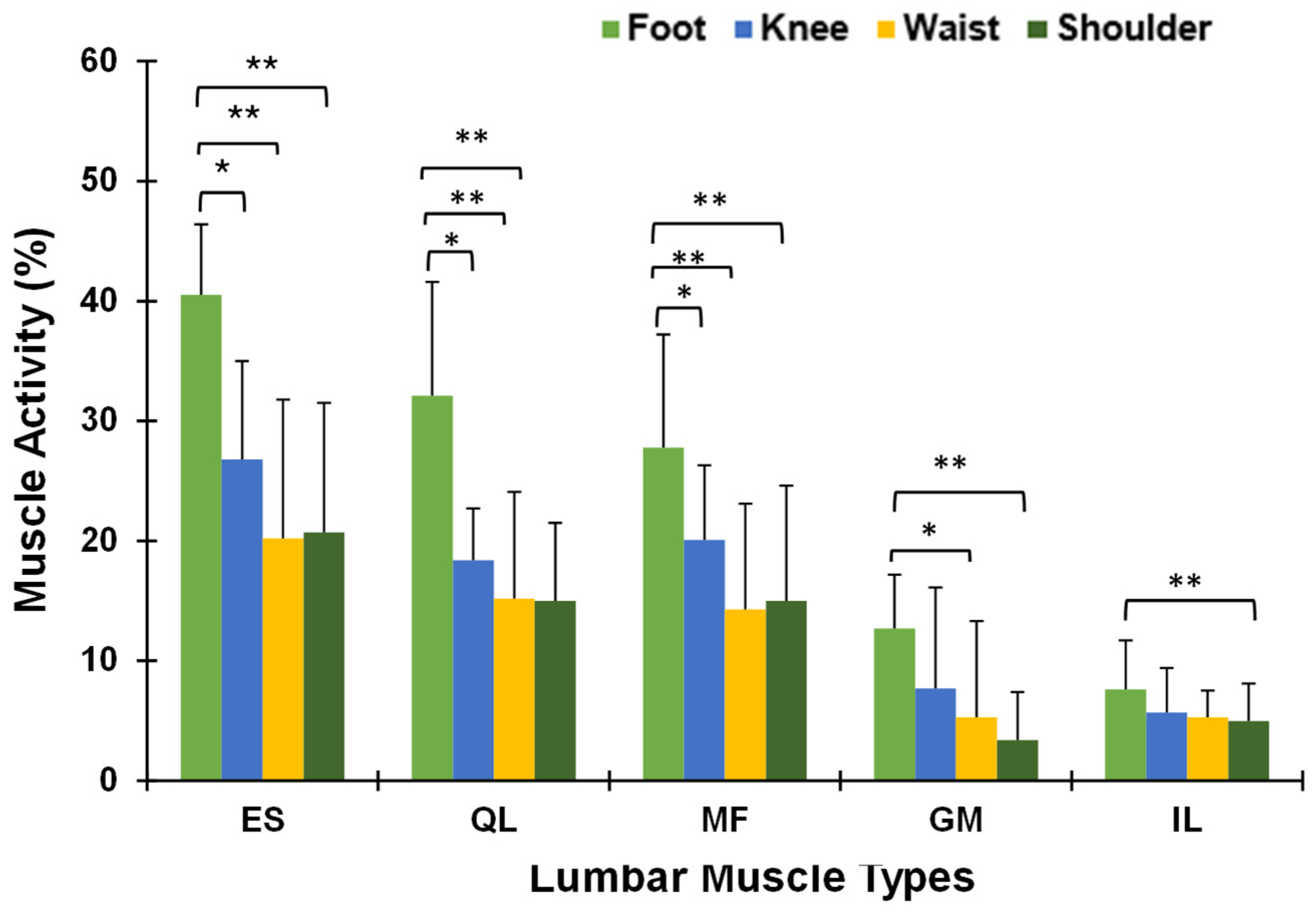


| Lumbar Muscle | Working Heights (cm) | F Ratio | p-Value | η2 | |||
|---|---|---|---|---|---|---|---|
| Foot | Knee | Waist | Shoulder | ||||
| ES | 40.6 (9.6) | 36.3 (8.7) | 39.2 (5.5) | 40.0 (6.0) | 10.3 | 0.001 ** | 0.15 |
| QL | 17.2 (7.2) | 18.5 (4.6) | 13.5 (5.3) | 15.9 (2.4) | 2.2 | 0.093 | 0.08 |
| MF | 13.9 (5.2) | 12.2 (7.6) | 11.6 (4.8) | 10.8 (4.6) | 3.8 | <0.011 ** | 0.09 |
| GM | 15.6 (4.6) | 12.3 (2.0) | 11.9 (3.0) | 12.8 (4.3) | 3.2 | <0.003 ** | 0.15 |
| IL | 13.7 (5.8) | 8.6 (2.4) | 9.7 (2.4) | 7.6 (2.7) | 8.3 | 0.001 ** | 0.3 |
| Lumbar Muscle | Working Heights (cm) | F Ratio | p-Value | η2 | |||
|---|---|---|---|---|---|---|---|
| Foot | Knee | Waist | Shoulder | ||||
| ES | 40.5 (5.9) | 26.8 (8.2) | 20.2 (11.6) | 20.7 (10.8) | 27 | <0.001 ** | 0.44 |
| QL | 32.1 (9.5) | 18.4 (4.3) | 15.2 (8.9) | 15.0 (6.5) | 30.7 | <0.001 ** | 0.47 |
| MF | 27.8 (9.4) | 20.1 (6.2) | 14.3 (8.8) | 15.0 (9.6) | 14.4 | <0.001 ** | 0.29 |
| GM | 12.7 (4.5) | 7.7 (8.4) | 5.3 (8.0) | 3.4 (4.0) | 10.3 | <0.001 ** | 0.23 |
| IL | 7.6 (4.1) | 5.7 (3.7) | 5.3 (2.2) | 5.0 (3.1) | 3.2 | 0.025 | 0.08 |
Disclaimer/Publisher’s Note: The statements, opinions and data contained in all publications are solely those of the individual author(s) and contributor(s) and not of MDPI and/or the editor(s). MDPI and/or the editor(s) disclaim responsibility for any injury to people or property resulting from any ideas, methods, instructions or products referred to in the content. |
© 2025 by the authors. Licensee MDPI, Basel, Switzerland. This article is an open access article distributed under the terms and conditions of the Creative Commons Attribution (CC BY) license (https://creativecommons.org/licenses/by/4.0/).
Share and Cite
Rahman, M.S.; Yazaki, T.; Chihara, T.; Sakamoto, J. Evaluating Lumbar Biomechanics for Work-Related Musculoskeletal Disorders at Varying Working Heights During Wall Construction Tasks. Biomechanics 2025, 5, 58. https://doi.org/10.3390/biomechanics5030058
Rahman MS, Yazaki T, Chihara T, Sakamoto J. Evaluating Lumbar Biomechanics for Work-Related Musculoskeletal Disorders at Varying Working Heights During Wall Construction Tasks. Biomechanics. 2025; 5(3):58. https://doi.org/10.3390/biomechanics5030058
Chicago/Turabian StyleRahman, Md. Sumon, Tatsuru Yazaki, Takanori Chihara, and Jiro Sakamoto. 2025. "Evaluating Lumbar Biomechanics for Work-Related Musculoskeletal Disorders at Varying Working Heights During Wall Construction Tasks" Biomechanics 5, no. 3: 58. https://doi.org/10.3390/biomechanics5030058
APA StyleRahman, M. S., Yazaki, T., Chihara, T., & Sakamoto, J. (2025). Evaluating Lumbar Biomechanics for Work-Related Musculoskeletal Disorders at Varying Working Heights During Wall Construction Tasks. Biomechanics, 5(3), 58. https://doi.org/10.3390/biomechanics5030058






